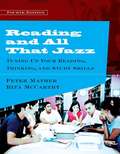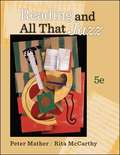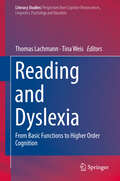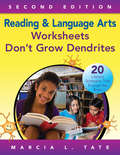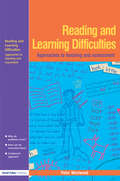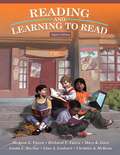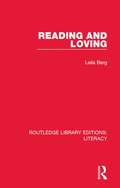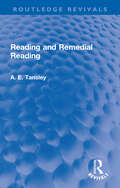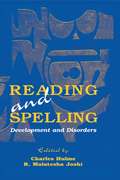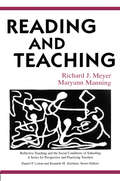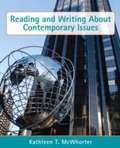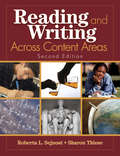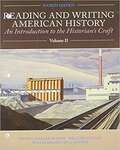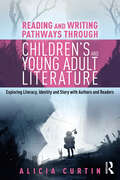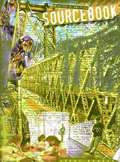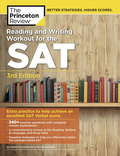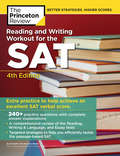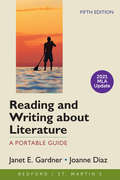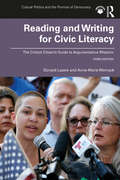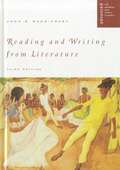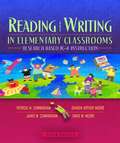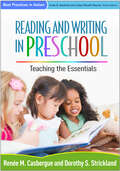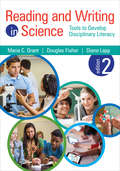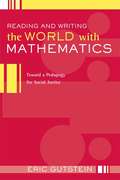- Table View
- List View
Reading and All That Jazz (4th Edition)
by Peter Mather Rita MccarthyThis attractive, engaging introductory-to-intermediate reading text for undergraduates begins by introducing students to study skills and the college environment, with readings on learning styles, different types of intelligence, stress, and other areas that help students understand themselves as learners. The text then broadens the perspective to focus on interpersonal, social, national, and international issues, within sections on discovering meaning through structure, interpreting written material, recognizing modes of writing, reading critically, and getting ready for content-area classes.
Reading and All That Jazz (5th Edition)
by Peter Mather Rita MccarthyReading and All That Jazz, an introductory-to-intermediate reading text, motivates and engages readers with contemporary and relevant readings while building the essential reading skills and vocabulary needed for literal and critical comprehension. With multiple practice opportunities and an adaptive learning plan via Connect Reading, Reading and All That Jazz provides for genuine thinking, assessment, and interpretation.
Reading and Dyslexia: From Basic Functions To Higher Order Cognition (Literacy Studies #16)
by Thomas Lachmann Tina WeisIn this volume a group of well-known experts of the field cover topics ranging from basic visual and auditory information processing to higher order cognition in reading and dyslexia, from basic research to remediation approaches and from well-established theories to new hypotheses about reading acquisition and causes for its failure. Reading is one of the most intriguing feats human evolution ever came up with. There is no evolutionary basis for reading as such; reading is secondary to language and the result of a complex skill acquisition at the end of which almost all pre-existing cognitive functions are mobilized. With the right instruction and practice most people learn this skill smoothly. Some, however, have problems, despite same opportunities and general cognitive abilities. This developmental dyslexia results from a neuro developmental disorder leading to deficits in reading relevant information processing. But what deficits are these, and can they be trained?
Reading and Language Arts Worksheets Don't Grow Dendrites: 20 Literacy Strategies That Engage the Brain
by Marcia L. TateBrain-based strategies turn reluctant readers into motivated learners! Building on Marcia Tate’s successful “dendrite-growing” teaching strategies, Reading and Language Arts Worksheets Don’t Grow Dendrites contains 300 instructional activities and brain-compatible literacy. Newly consistent with Common Core State Standards, this resource offers hands-on techniques to help teach reading in relevant, motivating, and engaging ways. Activities cover literacy instruction including: Phonemic awareness Phonics and vocabulary instruction Text comprehension Reading authentically, widely, and strategically Writing strategically Creating, critiquing, and discussing texts Conducting research Using technological resources Respecting diversity in language Participating in literary communities Using language to accomplish purposes
Reading and Learning Difficulties: Approaches To Teaching And Assessment
by Peter WestwoodFirst Published in 2005. Routledge is an imprint of Taylor & Francis, an informa company.
Reading and Learning to Read (8th Edition)
by Jo Anne L. Vacca Richard T. Vacca Mary K. Gove Linda C. Burkey Lisa A. Lenhart Christine A. MckeonReading and Learning to Read, 8/e is a highly-popular resource that expertly prepares pre-service and in-service teachers for today's ever-changing literacy classroom with its comprehensive coverage of philosophies, teaching strategies, and assessment practices. In addition, this book focuses on helping teachers implement effective research-based strategies with struggling and diverse learners; presents practical applications that engage students in new literacies and technology applications; and features the International Reading Association 2010 Standards for Reading Professionals. Professors, pre-service and in-service teachers will find this textbook user-friendly in format, design, and writing style; the expert knowledge is comprehensive and understandable.
Reading and Loving (Routledge Library Editions: Literacy #2)
by Leila BergOriginally published in 1977. Learning to read is probably the central educational achievement of any child's life. It is also a central concern for parents and teachers. Leila Berg, known for her work in children's literature, believes that the enjoyment of books and the acquisition of reading and writing is not primarily an academic or a technical skill, but grows from a warmly physical and emotional base of shared enjoyment with another human being. This book traces the varied ways that babies learn to communicate, and discusses the place of books in the lives of different groups in the community. It examines the types of books used in school, and demonstrates that, in many cases, books themselves provide the major inhibition to the development of reading through their stilted and often formalistic vocabulary. The author's aim is that all children's first experience of reading should be a loving and sensuous one, so that they can come to discover the power of books themselves.
Reading and Remedial Reading (Routledge Revivals)
by A. E. TansleyFirst published in 1967, Reading and Remedial Reading describes the normal reading programme in the school where the author taught and the diagnosis and treatment of acute difficulties in learning to read. The work deals mainly with so-called educationally maladjusted children, many of whom showed signs of possible damage to the central nervous system, but Mr Tansley believes that the methods and techniques given are applicable to all children, irrespective of levels of intelligence, who are experiencing difficulties to learn. The results achieved are most encouraging and have been tested by numerous expert visitors from this country and abroad. This is a helpful guide to a large number of people- staffs and students in University Education Departments, educational psychologists, remedial teachers, special-school teachers, primary school teachers, and medical officers in the School Health Service.
Reading and Spelling: Development and Disorders (Nato Science Series D: Ser. #87)
by Charles Hulme R. Malatesha JoshiThis volume includes chapters by a number of leading researchers in the area of reading and spelling development. They review what is currently known about both normal and impaired development of decoding, comprehension, and spelling skills. They also consider recent work on the remediation of reading and spelling difficulties in children and discuss effective remedial strategies.
Reading and Teaching (Reflective Teaching and the Social Conditions of Schooling Series)
by Richard Meyer Maryann ManningReading and Teaching raises questions and provides a context for preservice and practicing teachers to understand and to reflect on the complex issues surrounding the teaching of reading in the schools. It presents real teachers in their classrooms, dialogues about that teaching, and exercises for further clarification. The purpose is to help teachers make informed choices about their teaching of reading. The text considers the different types of decisions teachers might make in the teaching of reading and the knowledge upon which they rely in making those decisions—not simply factual information about using certain materials and methods to teach reading, but also knowledge about the mind, the political climate, the broader social and cultural circumstances of their students and schools and the communities in which they teach. Reading and Teaching is designed to engage teachers in beginning to evolve their own practical theories, to help them explore and perhaps modify some basic beliefs and assumptions, and to become acquainted with other points of view. Readers are encouraged to interact with the text and to develop their own perspective on the teaching of reading. This is the fifth volume in Reflective Teaching and the Social Conditions of Schooling: A Series for Prospective and Practicing Teachers, edited by Daniel P. Liston and Kenneth M. Zeichner. It follows the same format as previous volumes in the series. *Part I includes four real-life cases of teachers’ experiences in the classroom: “Teaching Reading Via Direct Systematic Instruction”; “A New Teacher Learns About Teaching Reading and Culture”; “A Teacher-Constructed Whole Language Program”; and “Critical Literacy in an Urban Middle School.” Each case is followed by space for readers to write their own reactions and reflections, educators’ dialogue about the case, space for readers’ reactions to the educators’ dialogue, and a summary and additional questions. *Part II presents three public arguments representing different views about the teaching of reading: direct instruction, whole language, and critical literacy.*Part III offers the authors’ own interpretations of the issues raised throughout the text and some suggestions for further reflection. A list of resources is provided. This text is pertinent for all prospective and practicing teachers at any stage in their teaching careers. It can be used in any undergraduate or graduate course that addresses the teaching of reading.
Reading and Writing About Contemporary Issues
by Kathleen T. McwhorterReading and Writing About Contemporary Issues offers an integrated approach to reading and writing using a handbook for reference and instruction followed by readings for analysis and writing.
Reading and Writing Across Content Areas
by Roberta L. Sejnost Sharon M. ThieseThis invaluable guide offers step-by-step, research-based strategies that will help you increase your students' reading comprehension, strengthen writing skills, and build vocabulary across content areas.
Reading and Writing American History: Volume 2
by Peter Hoffer William W. Stueck William James H. HofferIt is a combination reader, manual, and workbook that introduces students at all levels to the skills of the historian. <p><p> Following the chronological and thematic trajectory of the American history survey course, the authors explore primary and secondary sources, map skills, quantification, biography and a host of other basic historical techniques.
Reading and Writing Pathways through Children’s and Young Adult Literature: Exploring literacy, identity and story with authors and readers
by Alicia CurtinThis thought-provoking book will provide masters students, teachers and researchers with a toolkit and theoretical framework for teaching literacy through children's literature. It features innovative ideas for developing student and teacher experiences with literature and popular culture texts in the classroom, providing practical examples and teaching aids throughout. Taking a collaborative approach, Curtin explores how teachers and learners can engage with literature and its authors for the development of literacy in classroom practice. Connecting reader and writer identities and worlds through interviews with and suggested classroom activities from authors themselves, this text combines author, teacher and learner perspectives in the development of creative pedagogies that extend understandings of literacy beyond reading, writing and text. Exploring fairy-tales, comic books and graphic novels, children living in literature (i.e., texts which portray children, their lives and experiences), popular culture, young adult fiction, and non-fiction and digital texts such as blogs etc, this text develops a sociocultural understanding of literacy as a lived and contextually dependent practice where meaning is derived through relationships between people, settings and culture. Different contexts for literacy are explored, including reading and writing strategically (to learn about literacy and literature), widely (for personal purposes) and deeply (to transform understanding) (Short, 2011). This text will be an invaluable resource for teachers, researchers or anyone interested in reading and writing stories. The author interviews will also be of particular interest to older learners themselves as a way to develop their understanding of their own reading and writing practices. Pedagogies can be adapted to any age group, ranging from the early years to young adult.
Reading and Writing Sourcebook, Grade 10
by Robert Pavlik Richard G. RamseyWe often ask others to repeat things we don't hear clearly. Often the same thing happens when we read. We don't understand everything the first time through. That's one reason why it helps to read with a pen in hand, marking lines of text, circling words, underlining phrases, and asking questions in the margins. It's easy to do, and it will help you understand more of what you read.
Reading and Writing Workout for the SAT, 3rd Edition: Extra Practice to Help Achieve an Excellent SAT Verbal Score
by Princeton ReviewEXTRA PRACTICE FOR AN EXCELLENT SCORE. Get the extra prep you need for the SAT verbal score you want with this guidebook full of content review and strategies for tackling the SAT Evidence-Based Reading and Writing tests, plus 240+ practice questions with complete explanations.This eBook edition has been specially formatted for on-screen viewing with cross-linked questions, answers, and explanations.Techniques That Actually Work.· Tried-and-true tactics to help you focus on the important information in each passage· Tips for tackling tricky questions with elimination techniques· Essential strategies to help you maximize your efficiencyEverything You Need to Know to Help Achieve a High Score.· Expert review and drills for the grammar needed on the SAT Evidence-Based Reading and Writing tests· Comprehensive coverage of the various reading subjects and how to best tackle them, including dual passages and history/social studies, literature, and science topics· Up-to-date information on the SATPractice Your Way to Excellence.· Quick quizzes throughout each chapter to help assess understanding · Step-by-step walk-throughs that demonstrate tips for each type of question, from Main Ideas to Arguments· Detailed answer explanations that showcase each skill and strategy
Reading and Writing Workout for the SAT, 4th Edition (College Test Preparation)
by The Princeton ReviewSUCCEED ON THE SAT WITH THE PRINCETON REVIEW. Get targeted help for the Reading and Writing sections of the SAT with this top-rated guidebook. Includes reviews for exam topics, section-specific strategy help, and practice tests and drills. Designed for students specifically looking for extra help on the SAT Reading and Writing sections, this 4th edition of The Princeton Review's Reading and Writing Workout for the SAT provides the review and practice needed for subject mastery.Techniques That Actually Work.• Tried-and-true tactics to help you identify the important information in each passage• Essential strategies to help you maximize your efficiency• Tips for tackling tricky questions with elimination techniquesEverything You Need to Know to Help Achieve a High Score. • Expert review and drills for the grammar needed on the SAT Evidence-Based Reading and Writing tests• Comprehensive coverage of the various reading subjects and how to best tackle them, including dual passages and literature, history/social studies, and science topics• Up-to-date information on the SATPractice Your Way to Excellence.• 240+ total practice questions with complete answer explanations• Quick quizzes throughout each chapter to help assess understanding• Step-by-step walk-throughs that demonstrate tips for each type of question, from Main Ideas to Arguments• Detailed answer explanations that showcase each skill and strategy
Reading and Writing about Literature with 2021 MLA Update: A Portable Guide
by Janet E. Gardner Joanne DiazThis ebook has been updated to provide you with the latest guidance on documenting sources in MLA style and follows the guidelines set forth in the MLA Handbook, 9th edition (April 2021).Reading and Writing about Literature provides the essentials of reading and writing about literature in a brief and very affordable package.
Reading and Writing for Civic Literacy: The Critical Citizen's Guide to Argumentative Rhetoric, Brief Edition (Cultural Politics and the Promise of Democracy)
by Donald Lazere Anne-Marie WomackThis rhetoric-and-reader textbook teaches college students to develop critical reading, writing, and thinking skills for self-defense in the contentious arena of American civic rhetoric. This edition is substantially updated for an era of renewed tensions over race, gender, and economic inequality—all compounded by the escalating decibel level and polarization of public rhetoric. Readings include civil rights advocate Michelle Alexander on "the new Jim Crow," recent reconsiderations of socialism versus capitalism, Naomi Wolf’s and Christine Hoff Sommers’ opposing views on "the beauty myth," a section on the rhetoric of war, and debates on identity politics, abortion, and student debt. Designed for first-year or more advanced composition and critical thinking courses, the book trains students in a wealth of techniques to locate fallacies and other weaknesses in argumentation in their prose and the writings of others. Exercises also help students understand the ideological positions and rhetorical patterns that underlie opposing views, from Ann Coulter to Bernie Sanders. Widely debated issues of whether objectivity is possible and whether there is a liberal or conservative bias in news and entertainment media, as well as in education itself, are foregrounded as topics for rhetorical analysis.
Reading and Writing from Literature: AP Version (3rd edition)
by John E. SchwiebertDesigned for use in literature courses that are also writing courses, Reading and Writing from Literature offers a fresh new approach to reading and writing in those classes. The book invokes a "conversation" model of reading and writing that empowers students to interact proactively and constructively with all texts, both literary and their own. Reading and Writing from Literature presents reading as the primary resource for writing. Rather than only writing about literature, student users of this book write from literature; they use texts to produce texts. Being personally and culturally diverse, students are encouraged to identify and use those aspects of a text that interest them most as starting points for composing. Throughout the book, the guiding assumption is that, by creating, students also become stronger readers of the literature of past and present.
Reading and Writing in Elementary Classrooms: Research Based K-4 Instruction (5th Edition)
by David W. Moore Patricia M. Cunningham Sharon Arthur Moore James W. CunninghamThis K-4 text follows the style of the successful Cunningham/Allington franchise. It is very practical with tons of activities and grounded on solid research. With new chapters on Fluency, Assessment, and a new organization this text offers the most current insight on thinking processes, on reading and writing as language, and on the importance of the affective domain.
Reading and Writing in Preschool: Teaching the Essentials (Best Practices in Action)
by Dorothy S. Strickland Renée M. CasbergueThis book describes effective, engaging ways to build young children's print concepts and alphabetic knowledge, which are crucial for both reading and writing development. Presenting shared reading, shared writing, and targeted instructional activities, each chapter features helpful classroom vignettes, a section debunking myths about preschool literacy, and Ideas for Discussion, Reflection, and Action. Strategies are provided for creating print-rich classroom and home environments and differentiating instruction for diverse students, including English language learners. The book also discusses how to assess preschoolers' reading and writing progress. Reproducible checklists and parent handouts can be downloaded and printed in a convenient 8 1/2" x 11" size.
Reading and Writing in Science: Tools to Develop Disciplinary Literacy
by Douglas Fisher Maria C. Grant Diane K. LappEngage your students in scientific thinking across disciplines! Did you know that scientists spend more than half of their time reading and writing? Students who are science literate can analyze, present, and defend data – both orally and in writing. The updated edition of this bestseller offers strategies to link the new science standards with literacy expectations and specific ideas you can put to work right away. Features include: A discussion of how to use science to develop essential 21st century skills Instructional routines that help students become better writers Useful strategies for using complex scientific texts in the classroom Tools to monitor student progress through formative assessment When students are curious, they thrive. Give your students the strong base they need to create and share scientific ideas that have an impact in the classroom and beyond. "This is a teacher-friendly book that drew me in from the introduction to the end. Through real-life scenarios combined with useful methods for instruction, it illustrates how science teachers can use language as a tool for teaching science." -Trina Allen, Science Content Specialist Measurement Incorporated "An eminently readable guide for the novice and experienced teacher. The many practical ideas in this volume demonstrate that improving students’ skills in reading and writing can also improve their understanding and ability in science." - Cary Sneider, Associate Research Professor Portland State University, Portland, OR
Reading and Writing in Science: Tools to Develop Disciplinary Literacy
by Douglas Fisher Maria C. Grant Diane K. LappEngage your students in scientific thinking across disciplines! Did you know that scientists spend more than half of their time reading and writing? Students who are science literate can analyze, present, and defend data – both orally and in writing. The updated edition of this bestseller offers strategies to link the new science standards with literacy expectations and specific ideas you can put to work right away. Features include: A discussion of how to use science to develop essential 21st century skills Instructional routines that help students become better writers Useful strategies for using complex scientific texts in the classroom Tools to monitor student progress through formative assessment When students are curious, they thrive. Give your students the strong base they need to create and share scientific ideas that have an impact in the classroom and beyond. "This is a teacher-friendly book that drew me in from the introduction to the end. Through real-life scenarios combined with useful methods for instruction, it illustrates how science teachers can use language as a tool for teaching science." -Trina Allen, Science Content Specialist Measurement Incorporated "An eminently readable guide for the novice and experienced teacher. The many practical ideas in this volume demonstrate that improving students’ skills in reading and writing can also improve their understanding and ability in science." - Cary Sneider, Associate Research Professor Portland State University, Portland, OR
Reading and Writing the World with Mathematics: Toward a Pedagogy for Social Justice (Critical Social Thought)
by Eric GutsteinMathematics education in the United States can reproduce social inequalities whether schools use either "basic-skills" curricula to prepare mainly low-income students of color for low-skilled service jobs or "standards-based" curricula to ready students for knowledge-intensive positions. And working for fundamental social change and rectifying injustice are rarely included in any mathematics curriculum. <P><P>Reading and Writing the World with Mathematics argues that mathematics education should prepare students to investigate and critique injustice, and to challenge, in words and actions, oppressive structures and acts. Based on teacher-research, the book provides a theoretical framework and practical examples for how mathematics educators can connect schooling to a larger sociopolitical context and concretely teach mathematics for social justice.
